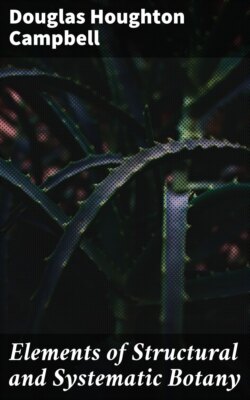Читать книгу Elements of Structural and Systematic Botany - Douglas Houghton Campbell - Страница 22
На сайте Литреса книга снята с продажи.
CHAPTER VI.
THE BROWN ALGÆ (Phæophyceæ).
ОглавлениеTable of Contents
Fig. 24.—Forms of diatoms. A, Pinnularia. i, seen from above; ii, from the side. B, Fragillaria (?). C, Navicula. D, F, Eunotia. E, Gomphonema. G, Cocconeis. H, Diatoma. All × 300.
These plants are all characterized by the presence of a brown pigment, in addition to the chlorophyll, which almost entirely conceals the latter, giving the plants a brownish color, ranging from a light yellowish brown to nearly black. One order of plants that possibly belongs here (Diatomaceæ) are single celled, but the others are for the most part large seaweeds. The diatoms, which are placed in this class simply on account of the color, are probably not closely related to the other brown algæ, but just where they should be placed is difficult to say. In some respects they approach quite closely the desmids, and are not infrequently regarded as related to them. They are among the commonest of organisms occurring everywhere in stagnant and running water, both fresh and salt, forming usually, slimy, yellowish coatings on stones, mud, aquatic plants, etc. Like the desmids they may be single or united into filaments, and not infrequently are attached by means of a delicate gelatinous stalk (Fig. 25).
Fig. 25.—Diatoms attached by a gelatinous stalk. × 150
They are at once distinguished from the desmids by their color, which is always some shade of yellowish or reddish brown. The commonest forms, e.g. Navicula (Fig. 24, C), are boat-shaped when seen from above, but there is great variety in this respect. The cell wall is always impregnated with large amounts of flint, so that after the cell dies its shape is perfectly preserved, the flint making a perfect cast of it, looking like glass. These flinty shells exhibit wonderfully beautiful and delicate markings which are sometimes so fine as to test the best lenses to make them out.
This shell is composed of two parts, one shutting over the other like a pill box and its cover. This arrangement is best seen in such large forms as Pinnularia (Fig. 24, A ii).
Most of the diatoms show movements, swimming slowly or gliding over solid substances; but like the movements of Oscillaria and the desmids, the movements are not satisfactorily understood, although several explanations have been offered.
They resemble somewhat the desmids in their reproduction.
